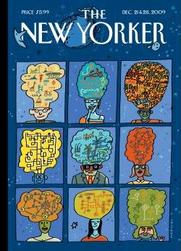Emdashes—Modern Times Between the Lines
The Basics:
About Emdashes | Email us
Ask the Librarians
Best of Emdashes: Hit Parade
A Web Comic: The Wavy Rule
Features & Columns:
Headline Shooter
On the Spot
Looked Into
Sempé Fi: Cover Art
Sempé Fi: Mundus Novus
Filed under: Sempé Fi Tagged: art, Art Spiegelman, Atom Style, atoomstijl, Cartoon Bank, Cobi, covers, environment, Françoise Mouly, Javier Mariscal, Olympics, Paul Gravett, Pollux, Saul Steinberg

Pollux writes:
In order to persuade Saul Steinberg to draw more covers for The New Yorker, art editor Françoise Mouly once showed the legendary artist some of the modern covers she had commissioned.
The only ones Steinberg liked were the covers created by Spanish artist Javier Mariscal. “It gave me goosebumps when I heard that,” Mariscal has commented, in this interesting piece by Paul Gravett.
To describe Mariscal as an artist would be an understatement. Mariscal is a one-man industry, a Renaissance Man of the Digital Age who has emerged from the Spanish posmodernidad to produce underground comics, furniture, paintings, sculptures, posters, sketches, murals, typography, product designs, interior decoration, animation, and audio-visual productions. Mariscal is a polymathic Valencian artist who has built a global empire based on whimsy, joyousness, and free-flowing experimentation.
It was Mariscal who designed Cobi, the two-legged doodle of a cat-like Catalan sheepdog for the 1992 Summer Olympics in Barcelona (most of Mariscal’s working life has been spent in Barcelona).
And so Mariscal is the perfect artist to illustrate the cover for the December 21 and 28, 2009 issue of The New Yorker. The theme of the issue is “World Changers” and Mariscal is an internationalist artist.
Mariscal’s relationship with The New Yorker is already well-established. Mariscal had contributed to Art Spiegelman’s comics anthology RAW and his previous covers for The New Yorker include, for example, the cover for the August 9, 1993 issue (*note*: this cover does not appear in the overhauled Cartoon Bank under the artist’s name or under the date of the issue itself). This 1993 cover depicts a frenetic seaside scene in which a cubist convertible careens along a Mediterranean corniche.
Mariscal’s new cover, called “New Worlds,” is an optimistic depiction of potential “world changers.”
Mariscal was a pioneer of the artistic movement known as Atom Style (also known as atoomstijl or Style Atome) that arose in the late 70s and early 80s, which was a throwback to the optimism of the 1950s when it was believed that anything was possible and technology could solve all of mankind’s problems.
In “New Worlds,” ideas burst out of the heads of men and women of all nationalities, ages, and backgrounds. Mariscal creates multi-shaped thought-balloons that fizz with new ideas and innovations. Mariscal’s squiggles, which fill up these multi-colored thought-balloons, create a new symbology that suggest possibilities for innovations in the fields of environmental science, transportation, linguistics, communication, energy, health, and medicine.
We can all be world changers, but no one can do it alone. The 193 nations that attended the United Nations Climate Change Conference in Copenhagen in December 2009 hammered out, with great difficulty, an accord that may lead to positive change. But more conferences, and more cooperation, are needed.
The best ideas emerge from chance, from flights of fancy and castles in the air, and Mariscal, himself an innovator and ideas man, creates doodles that represent the serendipity behind new discoveries.
Mariscal depicts not one struggling single figure in an ivory tower, but multiple figures in closely linked panels set against a universal background. Most of Mariscal’s figures smile. Each of Mariscal’s world changers is a constellation in the galaxy of change, happiness, and hope. Mariscal’s world changers are all “New Worlds.”




